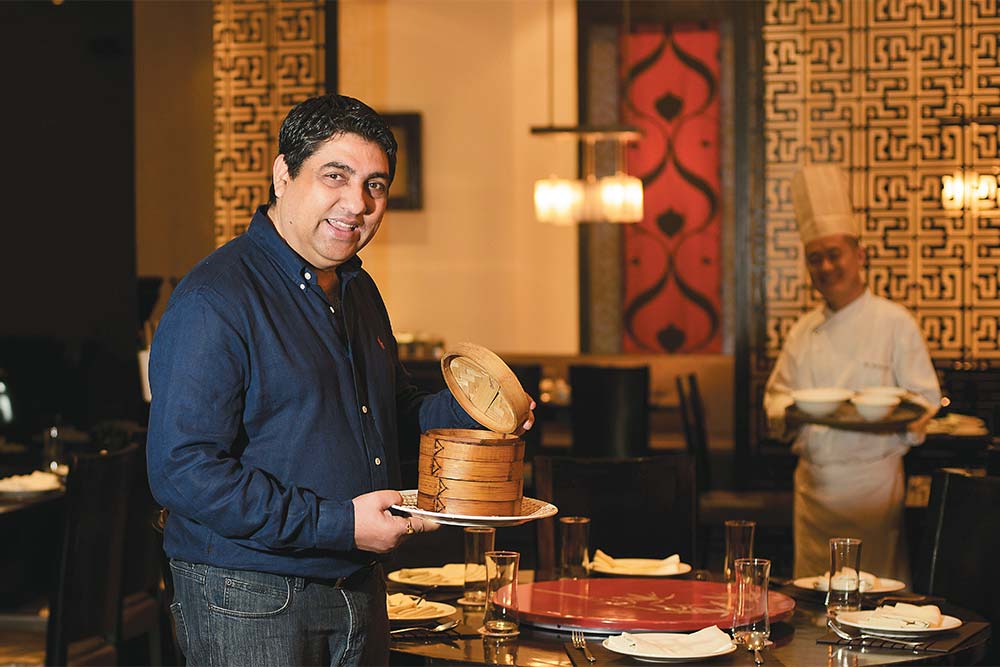Ved Srinivas, his wife and two children are regulars at Mainland China on Chennai’s Sterling Road. Many family birthdays, anniversaries and office promotions have been celebrated there. “The kids love noodles and sometimes it is the only way we can get them to eat spinach,” he says, referring to the crackling spinach that is a house speciality.
“My wife, too, is happy with the healthier options of dim sums and soups on their menu. But the best part is I don’t get a heart attack when I see the bill,” says the software engineer who eats out almost every weekend. More than the variety and the affordable prices on the menu, what’s won Srinivas’ loyalty is the restaurant’s attention to detail.
He’s always wished on birthdays and anniversaries and once, when a waiter noticed his mother was feeling cold in the air conditioning, he whipped out a shawl for her. It is customer experiences like these that have customers like Srinivas coming back for more, making Mainland China, which serves 9,500 customers everyday, into one of the most successful restaurant chains in the country.
Now, Speciality Restaurants, which owns Mainland China, wants a larger footprint across the country. Apart from Mainland China, the company runs several other restaurant chains, including Oh! Calcutta (Bengali cuisine), Sigree (North Indian), Kibbeh (Lebanese), and Flame & Grill (kebabs).
The man behind Speciality Restaurants is Anjan Chatterjee, adman turned restaurateur. Chatterjee founded Situations Advertising in 1985 but, given his long-standing passion and experiments with food, it didn’t surprise too many people when, in 1992, he entered the foods business in partnership with his wife Suchhanda. As Bengalis who love their rice and fish, starting off with Bengali cuisine seemed a natural choice and Only Fish was born.
Two years later, Chatterjee opened the first Mainland China restaurant in Andheri, a Mumbai suburb, when he found that Chinese was the most popular foreign cuisine in India, but there were no options that served good food at reasonable prices. In 1996, Only Fish became Oh! Calcutta and there are now nine restaurants in that chain. Mainland China, meanwhile, has become the largest Chinese fine dining chain in the country with 50 restaurants. In all, Speciality Restaurants now runs 89 restaurants (include 20 franchisees) and 13 confectioneries.
And the dream is definitely to grow bigger. So in a lacklustre market where many companies have called off their IPO plans, Speciality Restaurants went ahead with its offering of 11.7 million equity shares. After a slow start, the issue, which ended on May 18, was oversubscribed about 2.5 times and the final price has been fixed at #150 per share. The company will utilise the ₹176 crore raised through the public issue to expand its flagship brand, develop food plazas and repay an old term loan.
What’s on the menu
Between 2007 and 2011, Speciality Restaurants added about 11-12 restaurants every year. Now, over the next three years, it plans to increase that average to 15 a year, most of which, company-owned. Of the 45 new restaurants planned by FY15, 32 will be Mainland Chinas. “This is our most profitable brand. The more Mainland Chinas we open, the more profitable the company will be,” says Chatterjee. Indeed, the Chinese restaurant contributes 60% of the revenue and enjoys margins of 30-35%.
He has similar plans for Sigree as well, targeting to add seven more North Indian fine dining restaurants to the existing six by end FY15. Also in the works are joint brand restaurants where Mainland China will be combined with newer brands like Sigree. “We are hoping that people who come to eat at Mainland China will try Sigree on impulse and get hooked on to it as well,” explains Chatterjee.
Luckily for Speciality Restaurants, the timing is spot on. The ₹9,730-crore organised food services sector is tipped to grow an annual average 28% over the next couple of years, according to various industry reports.“When disposable incomes rise, you spend more on food. As people get more mobile and wealthy, they eat out more,” says GV Ravishankar, MD, Sequoia Capital, which invested $20 million in coffee chain Café Coffee Day and $5 million in wraps and rolls quick-service chain, Faaso’s.
Indeed, the foods business has been the flavour of the season with PE funds for the past three years. In 2008, SAIF Partners invested ₹90 crore for a stake in Speciality Restaurants valuing the firm at ₹450 crore. It currently has a 14.19% stake in the company, which will go down to 10.64% post the IPO. As per the red herring prospectus, the cost of acquisition of shares for SAIF was ₹71 per share, which means at the cut-off price of ₹150 a share, it has more than doubled its investment in four years.
In the same year, Everstone Capital, a Mumbai-based PE firm, which is again very bullish on the F&B business, created a holding company called Cuisine Asia for its investments in restaurants. It invested $30 million in Blue Foods, which runs the Copper Chimney, Noodle Bar and Spaghetti Kitchen chains, and forked out $20 million for a 45% stake Pind Balluchi, a Punjabi cuisine restaurant chain.
The proof of the pudding…
Hectic PE activity side, there aren’t too many success stories — yet. “Food is a complex business to build. You have to zero in on the right location and offer consistent quality across locations,” explains Jaspal Singh Sabharwal, partner at Everstone Capital. The reality is mortality rates in the foods business are uncomfortably high. “The going is tough and many players shut shop in a couple of years,” says Sabharwal. “But the period they are in business causes a lot of disruption in the market,” he adds.
Speciality has managed to grow well so far. It follows an asset-light model where it enters into a long-term lease for all its restaurant locations. “Commercial real estate costs are falling, which is a good sign for expansion for us,” says Chatterjee. He adds that it takes a Mainland China outlet about three to four months to achieve cash break-even. The average food bill per customer has climbed steadily, from ₹100 in 1994 to ₹650 now.
Chatterjee’s bias towards owned restaurants as opposed to franchisee-outlets also helps the company maintain better control over food quality and service, thereby ensuring brand standards are consistent across locations. Even in the franchisee outlets, Speciality retains control over critical components like food quality and guest attention. Getting the customer experience right plays a huge role in the success of a fine dining restaurant. Unlike a quick-service restaurant such as McDonald’s where the convenience is the selling point, in fine dining restaurants, the experience and ambience matter more. “Every interaction and every order is a moment of truth. So you need to execute really well,” points out Sequoia’s Ravishankar.
To its credit, Speciality seems to have handled the “moment of truth” pretty well. “The company has managed to offer its customers not only consistent food quality but a consistent customer experience across its locations by getting systems and process in place,” says Saloni Nangia, president, Technopak.
That’s showing up in the numbers as well. On average, the company’s revenues have grown 35% and profits 49% during 2007-11 — even during the slowdown in 2008 and 2009, revenue grew 60% and 39% respectively — driven largely by the expansion (from 17 in 2007 to 63 last year). But in the absence of same-store sales growth, one can’t say for sure if the company is completely insulated from recession. In the nine months ended December 2011, the company’s revenues were at ₹152 crore and net profit at ₹15.4 crore.
Post the IPO, the promoters’ stake will come down from 81% to 61%. At ₹150, the PE works out to 34 times its annualised nine months 2012 earnings on a diluted equity base. While the stock definitely does not come at a cheap price, it will be not be easy for most firms to replicate what Speciality Restaurants has done.
“Brands such as Mainland China and Copper Chimney have not been created overnight. It has taken them decades to build their business,” says Everstone’s Sabharwal. “They have extended their footprint on the ground besides meeting expectations in terms of food delivery and experience and proved their longevity in a high mortality business. That itself is a significant entry barrier that works in their favour,” he adds. What will also work in Speciality’s favour is the lack of options for investors in this space.
“There is always a scarcity premium to the earliest stocks that are listed and that should work in favour of Speciality Restaurants,” agrees Sequoia’s Ravishankar, who is more excited by the quick-service format in the long run. “It is hard to monitor the service quality across locations. It is easier when you have standardised products.”
Jubilant Foodworks, the company that owns Domino’s Pizza in India, is a case in point: the pizza chain currently has a valuation 70 times its 2011 earnings. Chatterjee believes that although his company may not achieve Jubilant’s scale, it will definitely match the company’s profitability.
Currently, both companies have similar Ebidta and net margins: 19.3% and 10.4%, respectively, for Jubilant, compared with 20.9% and 10.25% for Speciality. However, Jubilant’s return ratios are far better than Speciality’s. At the end of FY11, Jubilant had an ROE of 46% and ROCE of 50% compared with Speciality, whose figures were 18% and 24%, respectively. That may not change radically because fine dining restaurants are far more capital-intensive. “I would be happy with a fraction of the valuation Jubilant is commanding,” Chatterjee quips.
As it happens, Speciality will almost certainly list at a discount to Jubilant, which has the advantage of scale: 465 stores compared to Speciality’s 89. In the US, quick-service restaurants have enjoyed valuations higher than fine dining restaurants given their scale of operations. For instance, Mexican chain Chipotle, which is present in 1,400 locations, has a market cap of $12.44 billion while PF Chang, after which Mainland China is modelled on has a market cap of $1.09 billion.
A dull stock market will also play its role post-listing. If anything, the poor response to the issue is only a pointer to the challenges the stock will face when it debuts on the bourses. Sure, the buzz in the food services industry and the success of its flagship brand will lend support to the stock — it may clock modest gains, but nothing spectacular. It may be a better idea to whet your appetite in Chatterjee’s restaurants than to gobble up the stock in a hurry.












 Just one email a week
Just one email a week